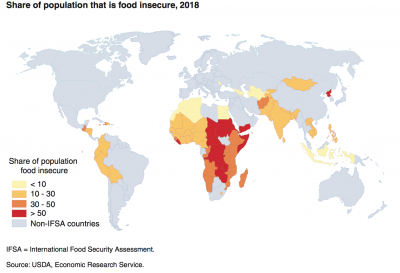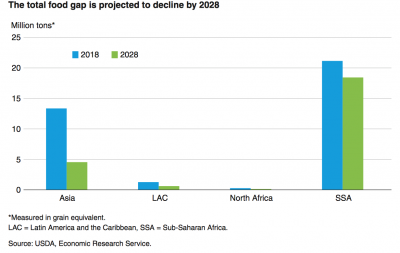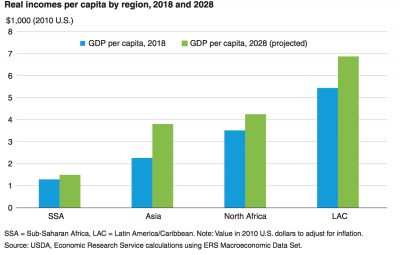Congress has quickly engaged in putting together potential aid packages for farmers that would more than double the Trump administration's $12 billion under the Farmer Bridge Assistance (FBA) Program.
Summary of ERS Report on International Food Security
Late last month, the U.S. Department of Agriculture’s Economic Research Service (ERS) released its latest report (“International Food Security Assessment, 2018-2028) in a continuous series of updates begun in the 1970s that explore issues associated with food security indicators. June’s update includes assessments for the current year and 10 years into the future. Today’s post includes highlights from the ERS report.
The report, which was written by Karen Thome, Birgit Meade, Kamron Daugherty, and Cheryl Christensen, stated that, “The ERS International Food Security Assessment (IFSA) model projects per capita food demand and evaluates that against a caloric target of roughly 2,100 calories per person per day to determine whether populations in 76 low- and middle-income countries (historic food aid recipients) should be considered food secure.
For the 76 countries covered by this report, 21 percent of the population was estimated to be food insecure in 2018. Thus, about 782 million people out of 3.7 billion total do not have access to the daily caloric target of 2,100 calories.

The report added, “Despite some setbacks, the total share of food-insecure people is projected to drop to 10 percent for the 76 countries studied by 2028, with the total number of food-insecure people dropping by 43 percent to about 446 million.”

“The total food gap is projected to decline in all regions and in most countries, from a total of 36 million tons in 2018 to 24 million tons in 2028, which is further demonstration of improving food security around the world,” the ERS report said.

More narrowly, the ERS economists noted, “While trends in food security are improving over time, food security indicators differ greatly by region: Sub-Saharan Africa (SSA) has the highest share of food-insecure people with 35.3 percent. Food insecurity is estimated to affect 19.5 percent in Latin America and the Caribbean (LAC) and 16.6 percent in Asia. The North Africa region has the lowest level of food insecurity, at an estimated 4.9 percent in 2018.”

Looking ahead, the report indicated that, “All regions are projected to see noticeable improvements over the coming decade, with the biggest improvement projected for Asia, where the share of the population that is food insecure is projected to fall more than 70 percent to 4.7 percent by 2028. Food insecurity in SSA improves by 32 percent, with a projected share of 24 percent in 2028. LAC is projected to improve to 9.5 percent food insecure, a drop of more than 50 percent. North Africa is on track to see a further decline in its food-insecure share, to 2.5 percent by 2028.”
And while addressing income, the ERS report pointed out that, “Per capita income is projected to increase in almost all countries from 2018 to 2028. Economic growth is initially slower than in the early 2000s, but then rises as economies affected by low oil and mineral prices begin to grow again and Asian GDP continues to expand. In Asia, strong GDP growth—particularly in India and Southeast Asia—combined with lower population growth has led to sustained improvements in per capita incomes. Despite improving GDP growth projections, rapid population growth in Sub-Saharan Africa means that its per capita income growth is the slowest of all regions.”

The report also noted that, “International food prices are expected to remain low in real terms over the projection period. Oil prices are projected to rise near the end of the projection period, however, and grain production is projected to increase due to increased global demand.”






